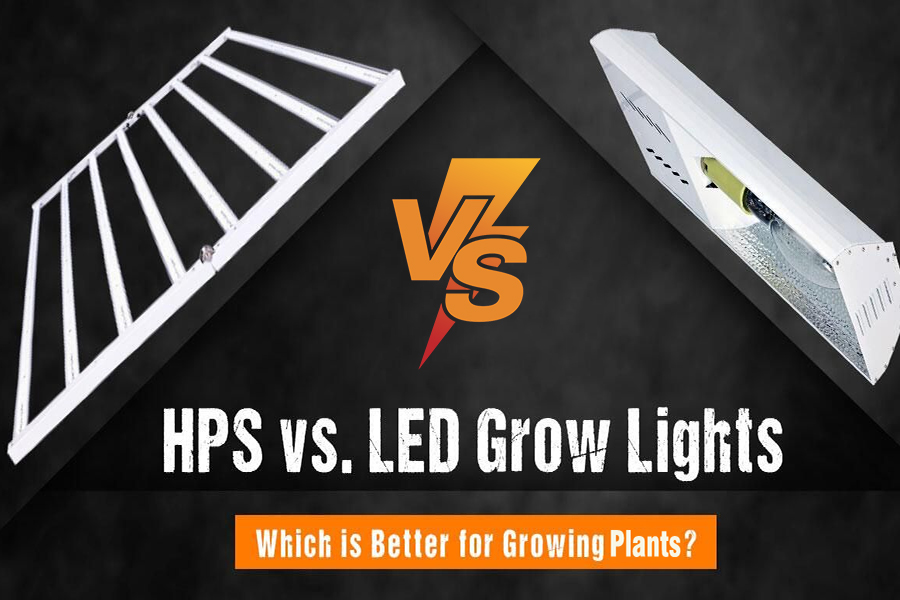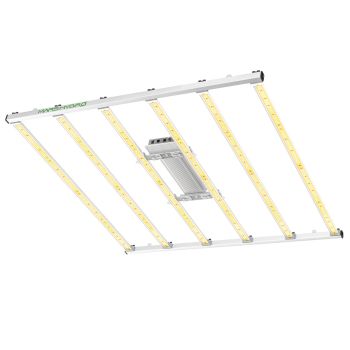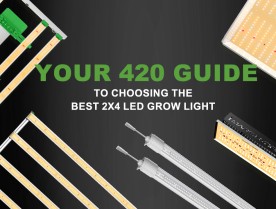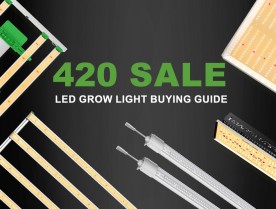
Since the mid-20th century, HPS grow lights have been the best available option for commercial indoor gardeners. Thus, it’s no surprise these traditional gas-discharge lights were the first choice for many farmers entering the emerging plants cultivation industry.
However, with the advent of LED grow lights, more cultivators are questioning their commitment to HPS bulbs. New LED models “outshine” HPS grow lights in virtually every category, including energy efficiency, ease of maintenance, and lifetime expectancy. As a bonus, LED grow lights give off a full spectrum of light, which translates to a larger, healthier plants crop.
No matter the size of your plants operation, it’s unlikely LED grow lights won’t help your bottom line.
HPS vs. LED Grow Lights — A Few “Enlightening” Definitions
Before revealing the benefits of using full-spectrum LED grow lights, let’s briefly go over what HPS and LED stand for.
HPS (High Pressure Sodium)
First off, HPS is short for “high-pressure sodium.” This gas-discharge light is so named because it produced high internal pressures versus its sister “low-pressure sodium” bulbs.
Each of these grow lights has a cylindrical aluminum-based “arc lamp” that contains a mix of chemicals like xenon, mercury, and sodium. When you turn on an HPS lamp, high-intensity voltage pulses between the arc lamp’s electrodes, thus “discharging” gas and producing light. Also, HPS grow lights come equipped with a ballast to help adjust the amount of voltage necessary to light the arc lamp.
LED (Light Emitting Diode)
LEDs refer to “light-emitting diodes,” which are tiny semiconductors that convert electrical current into visible light. Unlike gas-discharge HPS, LEDs are “solid-state” products because light is produced between two electrodes in each “solid” diode.
It’s worth mentioning that each LED could have a different “bandgap,” which changes the number of photons admitted through each diode. These differing bandgaps help explain why LED grow lights have multiple light spectrums.
So, Why Are LEDs So Much Better? Key Differences Between HPS and LED Grow Lights
Since HPS lamps have been around longer than LEDs, many still view them as the gold standard for indoor cultivation. However, even HPS proponents have to admit LEDs address many of this older model’s inefficiencies. Let’s run through a few common pros associated with using an LED grow light for plants.
Full-Spectrum LEDs Offer A Wider Array Of Wavelengths
In terms of light spectrums, HPS can’t hold a candle to LED grow lights. When you use HPS lamps, you’re only exposing your plants to monochromatic warm yellow patterns that have a correlated color temperature of 2200K. LEDs, however, offer a broad array of colors ranging from 2200K to 6000K.
While manufacturers could produce LEDs with specific light frequencies (e.g. “blurple” or UV), full spectrum LEDs offer the wide assortment of colors. To date, full spectrum LEDs like Mars Hydro are dedicated to growing plants, which accounts for their higher yields versus HPS.
Enjoy Longer Service Life With LED Grow Lights
As mentioned, HPS grow lights come equipped with a ballast to help adjust the amount of voltage necessary to light the arc lamp. As time goes on, HPS lamps require more voltage to produce the same amount of light, until it eventually wears out after about 24,000 hours. Moreover, HPS grow lamps tend to flicker at the end of their lifecycle.
By contrast, LED diodes won’t dampen as quickly as an HPS grow light. This is because LEDs require no high concentrations of gas, which inevitably “burns out” rather quickly. And they produce much less heat to ensure the core chips to take longer to fizzle out. Most LED grow lights last between 50,000 to 100,000 hours.
LEDs Will Keep Your Grow Space Cool
Another issue with using HPS grow lights is they give off a ton of heat. Indeed, HPS lamps produce so much heat that growers need to invest more money into cooling technologies and extra water. The excess heat from these lamps could also be a safety hazard, especially when you have to change out these bulbs or ballasts.
With LED grow lights, you won’t have to worry about managing excess ambient heat in your grow space. In fact, most LEDs only give off about 25 percent radiant heat versus 50 percent for HPS lights. You can rest assured that most of the energy going into your LEDs turns into light, not heat.
Concentrate Your Photons With Superior LED Directionality
Not only do HPS lamps have weaker light output due to their heat expenditure, the light they produce won’t be as concentrated as LED grow lights. Due to the HPS lamp’s inefficient design, light waves scatter 360° throughout your grow space.
By comparison, LED lamps focus light at 180°, making it easier for plants to absorb all of those photons for photosynthesis. When you order LEDs with in-built reflectors like those in Mars Hydro’s catalog, you can intensify this light further.
Thus, your yields will be much higher and more uniform under LEDs than HPS.
Are LEDs Worth The Higher Initial Cost?
Despite all the pros listed above, some growers are hesitant to switch to LEDs because of their higher upfront price. While it’s true many LEDs cost more than HPS lights upfront, they always reward a planter’s pocketbook in the long term.
Remember: LEDs require less energy to put out the same amount of wattage as HPS grow lights,for example, a 700w LED can emit same PAR as a 1000w HPS, thus can save more electric bills. Also, since LEDs don’t give off as much heat as HPS lights, you won’t have to worry about expenses like AC units, ventilation, or extra irrigation. As a bonus, since LEDs offer direct, full-spectrum light penetration, you will reap higher profits from your higher yields. What’s more, some high-quality LED grow lights passed DLC certification. In countries, government subsidies are awarded for using DLC-certified grow lights.
But it’s not just cost that has got people interested in LED grow lights. If you’ve ever used HPS grow lights in the past, you know what a pain it could be to change bulbs and ballasts safely. Installing lightweight LED panels is as simple as hanging them up and plugging them in. Plus, since LEDs have a longer lifespan versus HPS grow lights, you won’t have to worry about changing them all that often.
Want To Switch To LED Grow Lights? Remember The Following Tips
If you’re seriously considering switching to LEDs, please remember to re-adjust your irrigation and heating schedules. Since LED grow lights don’t give off as much heat, your plants will need less water and more nutrient-dense fertilizer to thrive. More Ca & Mg are welcomed.
Also, you should carefully monitor the temperature in your grow room since LEDs won’t give off the same degree of heat as HPS bulbs. As long as you keep these considerations in mind, you should make a smooth transition to lighting your plants with LEDs.
Therefore, replacing HPS with LEDs is an option to save money while reaping more. Hope you would enjoy your grow and the rewards from your yields with LED grow lights.
Thanks for watching.








